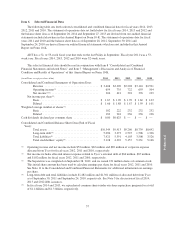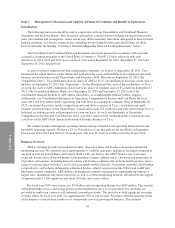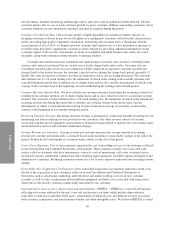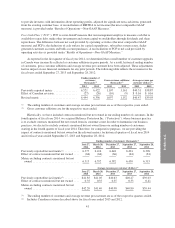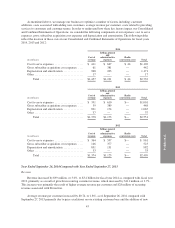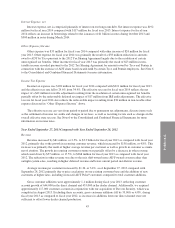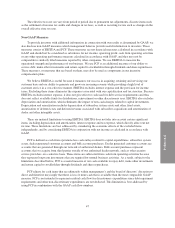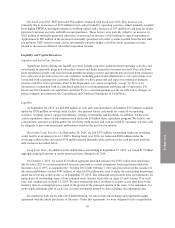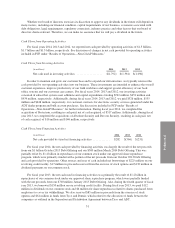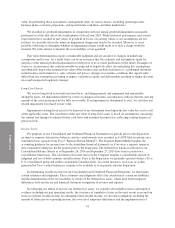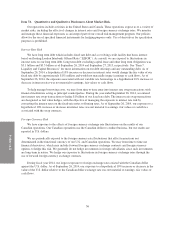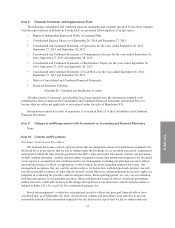ADT 2014 Annual Report Download - page 113
Download and view the complete annual report
Please find page 113 of the 2014 ADT annual report below. You can navigate through the pages in the report by either clicking on the pages listed below, or by using the keyword search tool below to find specific information within the annual report.
FORM 10-K
The effective tax rate can vary from period to period due to permanent tax adjustments, discrete items such
as the settlement of income tax audits and changes in tax laws, as well as recurring factors such as changes in the
overall effective state tax rate.
Non-GAAP Measures
To provide investors with additional information in connection with our results as determined by GAAP, we
also disclose non-GAAP measures which management believes provide useful information to investors. These
measures consist of EBITDA and FCF. These measures are not financial measures calculated in accordance with
GAAP and should not be considered as substitutes for net income, operating profit, cash from operating activities
or any other operating performance measure calculated in accordance with GAAP, and they may not be
comparable to similarly titled measures reported by other companies. We use EBITDA to measure the
operational strength and performance of our business. We use FCF as an additional measure of our ability to
service debt, make other investments and return capital to stockholders through dividends and share repurchases.
These measures, or measures that are based on them, may also be used as components in our incentive
compensation plans.
We believe EBITDA is useful because it measures our success in acquiring, retaining and servicing our
customer base and our ability to generate and grow our recurring revenue while providing a high level of
customer service in a cost-effective manner. EBITDA excludes interest expense and the provision for income
taxes. Excluding these items eliminates the expenses associated with our capitalization and tax structure. Because
EBITDA excludes interest expense, it does not give effect to cash used for debt service requirements and thus
does not reflect available funds for distributions, reinvestment or other discretionary uses. EBITDA also excludes
depreciation and amortization, which eliminates the impact of non-cash charges related to capital investments.
Depreciation and amortization includes depreciation of subscriber system assets and other fixed assets,
amortization of deferred costs and deferred revenue associated with subscriber acquisitions and amortization of
dealer and other intangible assets.
There are material limitations to using EBITDA. EBITDA does not take into account certain significant
items, including depreciation and amortization, interest expense and tax expense, which directly affect our net
income. These limitations are best addressed by considering the economic effects of the excluded items
independently, and by considering EBITDA in conjunction with net income as calculated in accordance with
GAAP.
FCF is defined as cash from operations less cash outlays related to capital expenditures, subscriber system
assets, dealer generated customer accounts and bulk account purchases. Dealer generated customer accounts are
accounts that are generated through our network of authorized dealers. Bulk account purchases represent
accounts that we acquire from third parties outside of our authorized dealer network, such as other security
service providers, on a selective basis. These items are subtracted from cash from operating activities because
they represent long-term investments that are required for normal business activities. As a result, subject to the
limitations described below, FCF is a useful measure of our cash available to repay debt, make other investments
and return capital to stockholders through dividends and share repurchases.
FCF adjusts for cash items that are ultimately within management’s and the board of directors’ discretion to
direct and therefore may imply that there is less or more cash that is available than the most comparable GAAP
measure. FCF is not intended to represent residual cash flow for discretionary expenditures since debt repayment
requirements and other non-discretionary expenditures are not deducted. This limitation is best addressed by
using FCF in combination with the GAAP cash flow numbers.
47


